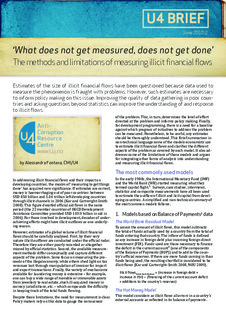| dc.contributor.author | Fontana, Alessandra | |
| dc.date.accessioned | 2018-01-04T08:18:07Z | |
| dc.date.available | 2018-01-04T08:18:07Z | |
| dc.date.issued | 2010-06-17 | |
| dc.identifier | oai:www.cmi.no:3720 | |
| dc.identifier.citation | Bergen: Chr. Michelsen Institute (U4 Brief 2010-2) 4 p. | |
| dc.identifier.uri | http://hdl.handle.net/11250/2474836 | |
| dc.description.abstract | Estimates of the size of illicit financial flows have been questioned because data used to measure the phenomenon is fraught with problems. However, such estimates are necessary to inform policy making on this issue. Improving the quality of data gathering in poor countries and asking questions beyond statistics can improve the understanding of and response to illicit flows. | |
| dc.language.iso | eng | |
| dc.publisher | Chr. Michelsen Institute | |
| dc.relation | U4 Brief | |
| dc.relation | 2010 No 2 | |
| dc.relation.ispartof | U4 Brief | |
| dc.relation.ispartofseries | U4 Brief 2010 No 2 | |
| dc.relation.uri | https://www.cmi.no/publications/3720-what-does-not-get-measured-does-not-get-done | |
| dc.subject | International Drivers of Corruption | |
| dc.title | 'What does not get measured, does not get done'. The methods and limitations of measuring illicit financial flows | |
| dc.type | Report | |
